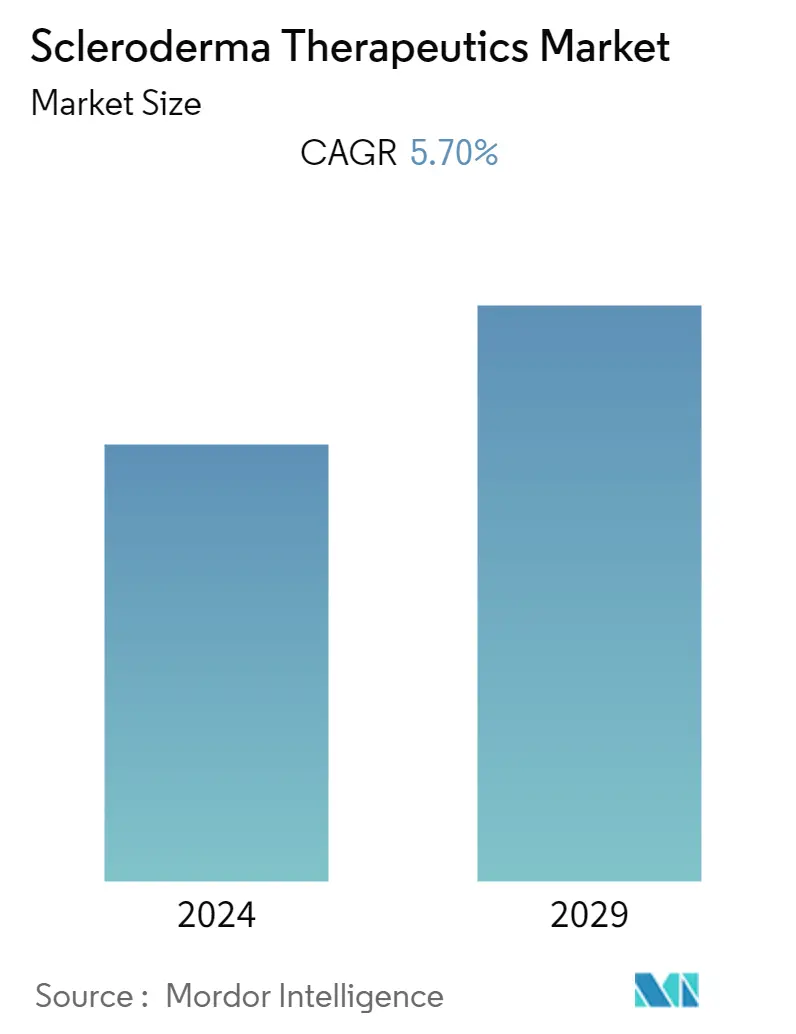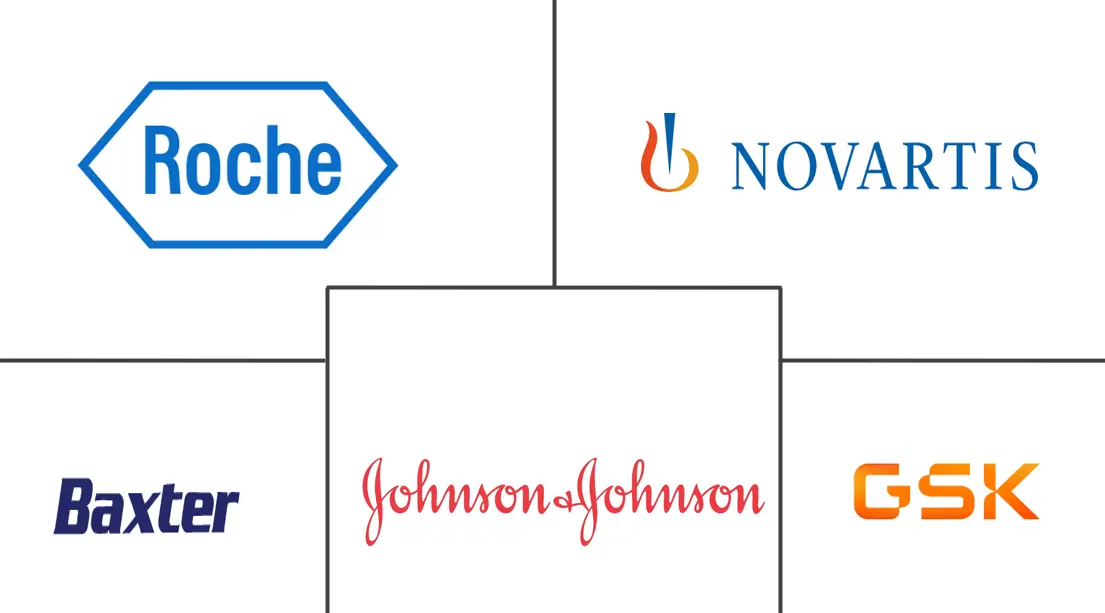Market Size of Scleroderma Therapeutics Industry

| Study Period | 2021 - 2029 |
| Base Year For Estimation | 2023 |
| Forecast Data Period | 2024 - 2029 |
| Historical Data Period | 2021 - 2022 |
| CAGR | 5.70 % |
| Fastest Growing Market | Asia Pacific |
| Largest Market | North America |
Major Players
*Disclaimer: Major Players sorted in no particular order |
Scleroderma Therapeutics Market Analysis
The scleroderma therapeutics market is expected to register a CAGR of 5.7% over the forecast period.
The COVID-19 pandemic negatively impacted the global scleroderma therapeutics market. An article published by the journal Lancet Rheumatology in August 2022 reported that COVID-19 led to restrictions that posed a severe challenge to managing pre-existing comorbidities like scleroderma, as doctors and healthcare professionals were busy treating and minimizing COVID-19 infections. However, with the substantial decrease in COVID-19 cases and resumptions of healthcare services, the scleroderma therapeutics market is expected to regain its growth pace. It is projected to show stable growth over the forecast period.
The factors driving the growth of this market are the rising prevalence of scleroderma and the development of novel drug therapies by pharmaceutical companies. An article published by European Medical Journal in May 2022 reported that localized scleroderma (LS) and systemic sclerosis (SSC) are increasing. The incidence of localized scleroderma (LS) in the United States is estimated to be 2.7 out of 100,000 persons. The incidence of systemic sclerosis worldwide is estimated to be 1.4 out of 100,000 person-years in 2021. Thus, the high incidence of this disease is increasing the demand for scleroderma therapeutics, thereby driving the growth of the studied market.
Technological developments have enabled pharmaceutical companies to focus on developing novel drugs. In October 2022, Scleroderma News reported that LMCD1 protein may be a potential novel therapeutic target for patients with SSc-ILD. LMCD1 protein is present at higher levels in the lungs of patients with interstitial lung disease (ILD) linked to systemic sclerosis (SSc) than in healthy individuals. Hence, it is a candidate target for the treatment of the disease. Such novel studies and research for developing novel therapeutics are driving the growth of the studied market.
Similarly, Drug Target Reviews in March 2022 reported that a unique macrophage, an immune cell that removes bacteria or dead cells, plays a vital role in the chronic inflammation and scarring in the lungs and skin of people with scleroderma, or systemic sclerosis. Scientists are targeting this macrophage for the development of drugs. Such studies are leading to the development of novel approaches for treating scleroderma, thereby driving the growth of the studied market.
Thus, due to the rising prevalence of scleroderma and the development of novel drug therapies by pharmaceutical companies, the studied market is expected to witness significant growth over the forecast period. However, regulatory and reimbursement issues may slow down the development of the market.
Scleroderma Therapeutics Industry Segmentation
Scleroderma is an autoimmune disease affecting the skin, blood vessels, muscles, and internal organs. The condition is usually caused due to an abnormal immune response. Therapies for this disease include immunosuppressive drugs and, in some cases, glucocorticoids.
The Scleroderma Therapeutics Market is Segmented by Disease Type (Systemic Scleroderma and Localized Scleroderma), Drug Type (Phosphodiesterase 5 Inhibitors - PHA, Prostacyclin Analogues, Immunosuppressants, Endothelin Receptor Antagonists, Calcium Channel Blockers, and Other Drug Types), and Geography (North America, Europe, Asia-Pacific, Middle East and Africa, and South America). The market report also covers the estimated market sizes and trends for 17 countries across major regions globally. The report offers the value (in USD million) for the above segments.
| By Disease Type | |
| Systemic Scleroderma | |
| Localized Scleroderma |
| By Drug Type | |
| Phosphodiesterase 5 Inhibitors - PHA | |
| Prostacyclin Analogs | |
| Immunosuppressants | |
| Endothelin Receptor Antagonists | |
| Calcium Channel Blockers | |
| Other Drug Types |
| By Geography | ||||||||
| ||||||||
| ||||||||
| ||||||||
| ||||||||
|
Scleroderma Therapeutics Market Size Summary
The scleroderma therapeutics market is poised for stable growth over the forecast period, driven by the increasing prevalence of scleroderma and advancements in drug therapies. The market experienced setbacks due to the COVID-19 pandemic, which diverted healthcare resources and attention away from managing chronic conditions like scleroderma. However, as healthcare services resume normal operations, the market is expected to recover and expand. Pharmaceutical companies are focusing on developing novel drug therapies, such as targeting the LMCD1 protein and unique macrophages, to address the disease's complexities. These innovations are expected to significantly contribute to market growth, despite potential regulatory and reimbursement challenges.
The market's expansion is further supported by the development of immunosuppressant drugs, which have shown promising results in alleviating scleroderma symptoms. Increased research and development investments are fostering the creation of new therapeutic molecules, with key market players actively pursuing innovative treatments. North America is anticipated to witness substantial growth due to its advanced healthcare infrastructure and the presence of non-profit organizations like the National Scleroderma Foundation, which raise awareness and support research. Collaborative efforts between pharmaceutical companies and non-profits are enhancing market demand. The competitive landscape is moderately consolidated, with several global and regional companies, including Boehringer Ingelheim and Johnson & Johnson, playing significant roles in shaping the market dynamics.
Scleroderma Therapeutics Market Size - Table of Contents
-
1. MARKET DYNAMICS
-
1.1 Market Overview
-
1.2 Market Drivers
-
1.2.1 Rising Prevalence of Scleroderma
-
1.2.2 Development of Novel Drugs by Pharmaceutical Companies
-
-
1.3 Market Restraints
-
1.3.1 Regulatory and Reimbursement Issues
-
-
1.4 Industry Attractiveness - Porter's Five Forces Analysis
-
1.4.1 Threat of New Entrants
-
1.4.2 Bargaining Power of Buyers
-
1.4.3 Bargaining Power of Suppliers
-
1.4.4 Threat of Substitute Products
-
1.4.5 Intensity of Competitive Rivalry
-
-
-
2. MARKET SEGMENTATION (Market Size by Value - USD Million)
-
2.1 By Disease Type
-
2.1.1 Systemic Scleroderma
-
2.1.2 Localized Scleroderma
-
-
2.2 By Drug Type
-
2.2.1 Phosphodiesterase 5 Inhibitors - PHA
-
2.2.2 Prostacyclin Analogs
-
2.2.3 Immunosuppressants
-
2.2.4 Endothelin Receptor Antagonists
-
2.2.5 Calcium Channel Blockers
-
2.2.6 Other Drug Types
-
-
2.3 By Geography
-
2.3.1 North America
-
2.3.1.1 United States
-
2.3.1.2 Canada
-
2.3.1.3 Mexico
-
-
2.3.2 Europe
-
2.3.2.1 Germany
-
2.3.2.2 United Kingdom
-
2.3.2.3 France
-
2.3.2.4 Italy
-
2.3.2.5 Spain
-
2.3.2.6 Rest of Europe
-
-
2.3.3 Asia-Pacific
-
2.3.3.1 China
-
2.3.3.2 Japan
-
2.3.3.3 India
-
2.3.3.4 Australia
-
2.3.3.5 South Korea
-
2.3.3.6 Rest of Asia-Pacific
-
-
2.3.4 Middle East and Africa
-
2.3.4.1 GCC
-
2.3.4.2 South Africa
-
2.3.4.3 Rest of Middle East and Africa
-
-
2.3.5 South America
-
2.3.5.1 Brazil
-
2.3.5.2 Argentina
-
2.3.5.3 Rest of South America
-
-
-
Scleroderma Therapeutics Market Size FAQs
What is the current Scleroderma Therapeutics Market size?
The Scleroderma Therapeutics Market is projected to register a CAGR of 5.70% during the forecast period (2024-2029)
Who are the key players in Scleroderma Therapeutics Market?
Boehringer Ingelheim International GmbH, Celgene Corporation, arGentis Pharmaceuticals Llc, Kadmon Holdings, Inc. and Emerald Health Pharmaceuticals are the major companies operating in the Scleroderma Therapeutics Market.

